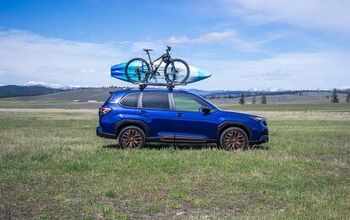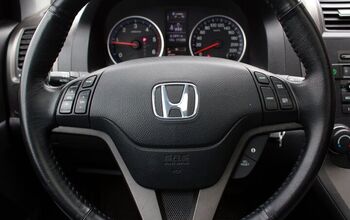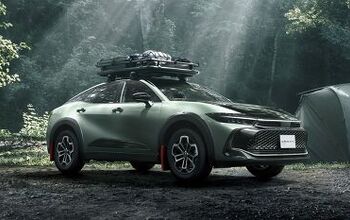2014 Lexus IS 350 F Sport Vs 2013 Cadillac ATS 2.0T

For as long as we (and probably most of you) can remember, there’s really only been one benchmark in the compact luxury sport sedan segment: the BMW 3 Series. Sure, there have been a few contenders and more than a few pretenders, but the 3 Series has consistently outperformed the competition by offering a driving experience that’s engaging enough to feel like foregoing sports car ownership hasn’t diminished your manhood.
Lexus has been trying to take a bite out of the 3 Series for almost a quarter of a century now, but truth be told, the luxury division of Toyota hasn’t had much success challenging BMW in terms of driving excitement. Things are changing at Toyota, though, the Lexus LFA boldly proclaiming the brand’s renewed interest in world-class performance. And the new 2014 Lexus IS certainly appears to be a serious effort, its Chief Engineer having publicly stated that the target was to be the most fun-to-drive car in the segment.
Meanwhile, Cadillac has been going through something of a renaissance of its own, slowly shedding its old man image thanks to the V-spec variants of its CTS sedan, coupe and wagon. And with the ATS claiming the 2013 North American Car of the Year award along with surprising proclamations by the media (including an early review by our very own Colum Wood) that it out-handles the BMW 3 Series, it was inevitable that we’d pit the ATS against the new Lexus IS at our local test track.
WHERE’S THE BIMMER?
Get the Flash Player to see this player.
Yes, we would have liked to bring a BMW 3 Series along to set a baseline to measure the ATS and IS against, but BMW didn’t have one available (that they’d let us put on the race track). So instead, we’ll have to make the best of the situation by briefly comparing the numbers on our 2.0-liter Turbo Performance AWD Caddy and our IS 350 F Sport Lexus. Admittedly two disparate trim levels, compare their prices and it’s not such a stretch.
While a 2.0-liter turbo model can be purchased for just a little over $36,000, add on AWD and upgrade to the Performance trim level and you’ll have added $10,000 to that price.
The IS 350 comes in at a more significant $39,465 to start, though all the F-Sport goodies don’t cost an absolute fortune and will set you back an additional $3,620 for an as-tested price of $43,980 including delivery. That F Sport package includes 18-inch wheels wrapped in high performance summer tires, twin projector LED headlights, and of course that aggressive front fascia and grille.
Trim out a BMW 328i with the Sport Line package and a few other add-ons like driver assistance and lighting packages and you’re quickly up into the same ballpark at $49,375.
Of the three, the Bimmer has the worst power-to-weight ratio, a function of having the least powerful engine, a 2.0-liter turbocharged 4-banger that puts out 240 hp, while not exactly being a lightweight at 3,410 lbs. The IS 350 is the horsepower leader here, it’s widely used 3.5-liter V6 making a solid 306 hp, but it’s also the heaviest at 3,593 lbs. The all-wheel drive ATS sits in the middle on both counts, thanks to its 272 hp turbocharged 2.0-liter engine and a curb weight of 3,537 lbs, though in rear-wheel drive trim it’s actually 52 lbs lighter than the BMW.
WHERE’S THE JOY?
There’s a lot more to performance and driver enjoyment than just power-to-weight ratio, though, a truth Toyota has recently taken to a whole new level with the incredibly agile GT-86 ( Scion FR-S and Subaru BRZ in our market). But has any of the purity of the GT-86 experiment trickled uphill to Toyota’s luxury division and into the DNA of the new IS?
Visually, there’s certainly a lot of joy in the F Sport front fascia, its gapping maw and unique LED “swooshes” beneath the main headlamps giving it a bold and exuberant appearance. The optional and totally awesome digital instrumentation, inspired by the LFA’s similarly high-tech gauge cluster, also suggests you’ve just buckled yourself into a serious performance machine, but out on the race track the experience is considerably more subdued.
For starters, there’s no manual gearbox option in this or any other Lexus, so there’s an immediate disconnect between man and machine. Not that all automatic transmissions are incapable of delivering immediate on-demand gear changes, but in the IS 350 I was often having to request downshifts multiple times before the transmission would comply, sometimes waiting until the middle of the corner where it would upset the chassis’ balance. Not exactly a recipe for fast laps or a sense of driving joy.
Strike Two for the IS 350 was the omnipresent understeer, especially when pushed to the limit, a characteristic both Colum and I felt was likely being made worse by the F Sport package’s wider rear tires. Between the transmission’s unwillingness to downshift and the rear-biased tire setup, we simply couldn’t get the back end to come loose. In fact, attempts to use the throttle to induce oversteer instead resulted in even more understeer. A luxurious 4-door Scion FR-S this is not!
The Cadillac ATS wasn’t without its faults, either. Its 4-cylinder turbocharged engine was being asked to do an awful lot of heavy lifting when attached to a 3,500-lb AWD chassis, and it showed. After just a couple of hot laps, I could feel the Caddy’s engine starting to struggle down the straight-aways, as it became increasingly heat soaked. Not terribly surprising given the hot and sticky weather (reaching well above the 90-degree mark), but I wasn’t expecting the ATS to overheat so badly that it went into ‘safe’ mode, cutting power and limiting RPM on the third lap.
After a few cool down laps I turned up the aggression again, and this time it was the Cadillac’s 6-speed automatic transmission that went into self-preservation mode, the dash lighting up and alarms going off, along with a digital message on the center display that stated, “immediate action required”. A bit of an ambiguous message for a racer like me, but I made the safe choice and opted to park the ATS in the shade, where its equally overworked Lexus counterpart soon joined it.
WHERE’S THE SPORT?
At this point, it’s fair to say both Colum and I were underwhelmed by the performance delivered by both of these alleged 3 Series fighters. The Lexus was quick in a straight line and had fade-free brakes with excellent pedal feel, but its power-on understeer was bewildering and its 8-speed automatic transmission also overheated shortly after the ATS’, giving us a similar “cool it” message.
Despite my concerns that the AWD system would result in a lot of unwanted understeer, the ATS was the more willing of the two to change direction, plus it has superb steering feel and precision to go along with fade-free Brembo brakes. But its all-season tires were no match for the F Sport’s summer tires, and at no point did it feel like the AWD system was giving the Caddy a traction advantage coming out of the corners. Throw in a fun-sucking slushbox transmission and there was a notable absence of joy as we sat around in the paddock waiting for both cars to cool down.
In Cadillac’s defense, they do offer the 2.0-liter Turbo ATS with a 6-speed manual transmission, a gearbox that would unquestionably be better suited to the track. Sadly, GM didn’t have one available at the time, nor did they have a RWD version with the more potent 321 hp 3.6L V6 available, a trim level that’s strangely only available with an automatic transmission. Why Cadillac doesn’t offer enthusiast-buyers a RWD V6 model with a manual gearbox is beyond me, but perhaps we can look forward to an ATS-V that gives us exactly that.
Lexus, on the other hand, has no such defense, since the IS 350 F Sport is the top of the line model, so its shortcomings can’t be explained away by changes to its trim level. This is the best and fastest IS money can buy, unless Lexus decides to build a new IS-F, but then we’re getting into BMW M3 territory.
WHERE’S THE LAP TIMES?
With the sun setting, both cars fully cooled off and ambient temps below 90-degrees, I was finally able to complete three flying laps in both cars without any safe mode intervention or other obvious signs of performance drop-off. Both cars were, of course, put in ‘Sport’ mode and had all stability and traction control systems turned off (or at least as off as they’d go).
Despite the Cadillac being equipped with GM’s superb magnetic ride, featuring the same highly-tunable magnetorheological shock absorbers as the Corvette ZR1 and Camaro ZL1, it was the Lexus that felt better damped around the race track, having less body roll and a more poised feel as I ran it up onto the curbing at the apex of each corner. And when I decided to drive it less like a Scion FR-S, the IS 350 did start to feel more balanced and willing to turn-in and stay on line. The Lexus definitely requires more of a ‘slow in, fast out’ driving style, which for me takes some of the joy out of the experience, but it can still be an effective way to go fast, the F Sport posting a respectable lap time of 1-minute 26.6-seconds.
Compare Specs
| Vehicle | 2013 Cadillac ATS 2.0L Turbo | Advantage | 2014 Lexus IS 350 F-Sport |
|---|---|---|---|
| Engine | 2.0L Turbo-4 | - | 3.5L V6 |
| Horsepower | 274 | IS 350 | 306 |
| Max. Torque | 260 | IS 350 | 277 |
| Transmission | 6-Speed Automatic | IS 350 | 8-Speed Automatic |
| 0-60 Time | 5.8 seconds | IS 350 | 5.6 seconds |
| Max Lateral g's | 1.06g | IS 350 | 1.07g |
| Max Braking g's | 0.76g | IS 350 | 0.93g |
| Max Speed | 91.5 mph | IS 350 | 99.5 mph |
| Total Lap Time | 1:29.169 | IS 350 | 1:26.610 |
Although it had more pitch and roll than expected, the Cadillac ATS was unquestionably the better balanced of the two vehicles, showing virtually no signs of turn-in understeer and a wonderful willingness to rotate by the apex. With more power on tap it would have been possible to induce even earlier rotation with the throttle, but even with the hard-working 4-cylinder turbo engine the ATS certainly lived up to the media hype while navigating the twist bits of our test track. If it’s not a better handling machine than the BMW 3 Series, it’s very, very close, and presumably the RWD version of the ATS is even pointier than our AWD test mule (Colum assures me it is).
In the end the Caddy just didn’t have enough motor to keep up with the Lexus, though. With a best lap time of 1-minute 29.1-seconds, the ATS was getting left in the dust down the straight-aways. And because the IS 350 was on a high performance summer tire, the in-car data clearly shows its grip advantage, with big spikes in initial cornering g’s as well as a huge advantage in braking g’s to go along with a much steeper reduction of speed in the braking zones. Had the Caddy been equipped with comparable summer tires, the lap times would have been much closer.
THE VERDICT: CAN BMW REST EASY?
Based on our results from this hot and sticky summer day, it’s impossible to proclaim either the Lexus or the Cadillac the new leader in the compact luxury sport sedan segment. Still, the ATS does indeed have Bimmer-hunting handling dynamics, and when you trim out its cleanly designed interior with red leather and carbon accents it’s downright sexy inside. Too bad Cadillac didn’t take more risks with its exterior styling, though, because its sheet metal still has a whiff of old man about it.
The IS 350, on the other hand, certainly has the extroverted styling (especially in F Sport trim) and onboard luxury and technology to rival BMW and anything else in its class, but despite posting the faster lap time the Lexus just doesn’t deliver the kind of driving excitement a rear-wheel drive sports sedan should.
For 50-grand, neither the ATS (at least in 2L Turbo Performance AWD trim) nor the IS 350 F Sport blend luxury, style and performance in a way the 3 Series does. But these are both first model year efforts, and with some joy-enhancing tweaks one of these contenders just might have what it takes to knock the 3 Series off its perch.
2014 Lexus IS 350 F Sport RWD, 2013 Cadillac ATS 2.0 Turbo Performance AWD
LOVE IT
- Extroverted front fascia and grille
- Digital instrumentation is delicious eye candy
- Fade-free brakes with excellent pedal feel
- Excellent at-the-limit chassis balance
- Precise and communicative steering
- Cleanly designed interior feels fresh
LEAVE IT
- Relentless understeer if pushed hard
- Uncooperative automatic transmission
- Lack of hoonability
- Yawn-inducing exterior styling
- Limited backseat legroom
- Some interior trim pieces lack premium feel

Some say he's closely related to Bigfoot and that he's a former Canadian Touring Car Champion. All we know is he's the AutoGuide Stig! A thesis defense away from being your intellectual superior he's a professor of vehicle handling dynamics. The part-time touring car and time attack racer is faster (much faster) than your average auto journalist.
More by Dave Pratte






























Comments
Join the conversation